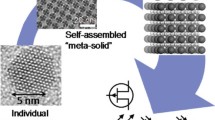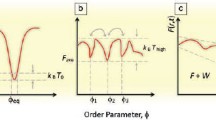Abstract
While self-organization has been an integral part of academic discussions about the distinctive features of living organisms, at least since Immanuel Kant’s Critique of Judgement, the term ‘self-assembly’ has only been used for a few decades as it became a hot research topic with the emergence of nanotechnology. Could it be considered as an attempt at reducing vital organization to a sort of assembly line of molecules? Considering the context of research on self-assembly I argue that the shift of attention from self-organization to self-assembly does not really challenge the boundary between chemistry and biology. Self-assembly was first and foremost investigated in an engineering context as a strategy for manufacturing without human intervention and did not raise new perspectives on the emergence of vital organization itself. However self-assembly implies metaphysical assumptions that this paper tries to disentangle. It first describes the emergence of self-assembly as a research field in the context of materials science and nanotechnology. The second section outlines the metaphysical implications and will emphasize a sharp contrast between the ontology underlying two practices of self-assembly developed under the umbrella of synthetic biology. And unexpectedly, we shall see that chemists are less on the reductionist side than most synthetic biologists. Finally, the third section ventures some reflections on the kind of design involved in self-assembly practices.
Similar content being viewed by others
Notes
The phrase ‘soft chemistry’ (chimie douce in French) has been coined in a programmatic tone by Jacques Livage “Vers une chimie écologique” Le Monde, 26 October 1977 where he formulated the question: “will it be possible to invent a soft chemistry would be harmoniously integrated in natural processes?”
Maureen O’Malley (2009) has rightly emphasized the gap between this self-representation of a number of synthetic biologists and their actual engineering practice, which involves a lot of kludging.
References
Atlan, H. (1972). L’organisation biologique et la théorie de l’information. Paris: Hermann.
Atlan, H. (1979). Entre le cristal et la fumée. Paris: Seuil-Point science.
Ball, P. (2002). Natural strategies for the molecular engineer. Nanotechnology, 13, 15–28.
Barad, K. (2003). Posthumanist performativity: Toward an understanding of how matter comes to matter. Signs, 28(3), 801–831.
Benner, S., Chen, F., & Yang, Z. (2011). Synthetic biology, tinkering biology, and artificial biology: A perspective from chemistry. In P. L. Luisi & C. Chiarabelli (Eds.), Chemical Synthetic Biology (pp. 69–106). Chichester: Wiley.
Bensaude Vincent, B. (2013). Discipline building in synthetic biology. Studies in History and Philosophy of Biological and Biomedical Sciences, 44(2), 122–129.
Bensaude Vincent, B., Loeve, S., Nordmann, A., & Schwarz, A. (2011). Matters of interest: The objects of research in science and technoscience. Journal for General Philosophy of Science, 42(2), 365–383.
Bernard, C. (1885). Leçons sur les phénomènes de la vie communs aux animaux et aux végétaux. Paris: Librairie Germer Baillière.
Bernard, C. (1984). Introduction à l’étude de la méthode expérimentale en médecine, 1865. Paris: Flammarion.
Berthelot, M. (1860). La chimie organique fondée sur la synthèse. Paris: Alcan.
Brooke, J. H. (1968). Wöhler’s urea and its vital force—A verdict from the chemists. Ambix, 15, 84–114.
Church, G., & Regis, E. (2012). Regenesis: How synthetic biology will reinvent nature and ourselves. New York: Basic Books.
Deplazes, A. (2009). Piecing together a puzzle. EMBO Reports, 10(2009), 428–432.
Editorial. (2007). Meanings of “Life”: Synthetic biology provides a welcome antidote to chronic vitalism. Nature, 447: 1031–1032.
Feltz, B., Crommelinck, M., & Goujon, P. (2006). Self-organization and emergence in life sciences. Dordrecht: Springer.
Fox, Keller E. (2000). The century of the gene. Cambridge: Harvard University Press.
Fox, Keller E. (2002). Making sense of life. Cambridge: Harvard University Press.
Gibson, D. G., Glass, J. L., Lartigue, C., et al. (2010). Creation of a bacterial cell by a chemically synthesized genome. Science, 328, 52–56.
Guchet, X. (2009). Nature and artefact in nanotechnology. Hyle, 15(1), 5–14.
Harré, R. (2003). The materiality of instruments in a metaphysics for experiments. In H. Radder (Ed.), The philosophy of experimentation (pp. 19–38). Pittsburgh: Pittsburgh University Press.
Hutchinson, C. A., Gibson, D. G., & Venter, C. J. (2016). Design and synthesis of a minimal bacterial genome. Science, 351(6280), 1414.
Jacob, F. (1981). Le Jeu des possibles, Paris, Fayard. Engl Tr The Possible and the Actual. New York: Pantheon Books, 1982.
Larrère, R. (2015). Penser et agir avec la nature. Paris: Éditions de la découverte.
Latour, B. (1993). We have never been modern. Cambridge : Harvard University Press.
Lehn, J. M. (2003). Une chimie supramoléculaire foisonnante. La lettre de l’Académie des sciences, 10, 12–13.
Lehn, J. M. (2012). Constitutional dynamical chemistry, bridge from supramolecular chemistry to adaptive chemistry. In M. Barboiu (Ed.), Constitutional dynamical chemistry (pp. 1–32). Dordrecht: Springer.
Luisi, P. L., & Chiarabelli, C. (Eds.). (2011). Chemical synthetic biology. Chichester: Wiley.
Maasen, S. (2006). The assembled self of nanotechnology: The career of self-assembly as a metaphor. Paper presented at EASST Conference, Lausanne.
Mann, S., Webb, J., & Williams, R. (Eds.). (1989). Biomineralization: Chemical and biological perspectives. Weinheim: VCH.
Nicolis, G., & Prigogine, I. (1977). Self-organization in nonequilibrium systems: From dissipative structures to order through fluctuations. New York: Wiley.
Nordmann, A. (2010). Enhancing Material Nature. In K. Lein Kjølberg & F. Wickson (Eds.), Nano meets macro: social perspectives on nanoscale sciences and technologies (pp. 283–306). Singapur: Panstanford.
O’Malley, M. (2009). Making knowledge in synthetic biology: Design meets kludge. Biological Theory, 4, 378–389.
Prigogine, I., & Stengers, I. (1984). Order out of chaos: Man’s new dialogue with nature. New York: Bantam Books.
Ramberg, P. (2000). The death of vitalism and the birth of organic chemistry: Wölher’s urea synthesis and the disciplinary identity of chemistry. Ambix, 47, 170–195.
Riskin, J. (2015). The restless clock. A history of century-long argument over what makes living things yick. Chicago: The University of Chicago Press.
Serres, M. (1989). Gnomon, les débuts de la géométrie grecque. In M. Serres (Ed.), Eléments d’histoire des sciences (pp. 63–99). Paris: Bordas.
Simondon, G. (1952). Epistémologie de la cybernétique, unpublished paper.
Simondon, G. (1958). Du mode d’existence des objets techniques. Paris: Aubier-Montaigne 2nd ed. 1989.
Smalley, R. E. (2001). Of chemistry, love and nanobots. Scientific American, 285(3), 76–77.
Smalley, R. E. (2003). Discovering the fullerenes. In I. Grenthe (Ed.), Nobel lectures, chemistry 1996–2000 (pp. 89–103). Singapore: World Scientific Publishing.
Stengers, I. (1985). Les généalogies de l’auto-organisation. Cahiers du CREA, 8, 7-104 (in the archives of CREA, 1 rue Descartes, 75005, Paris).
Venter C. (2010). Press Conference https://www.ted.com/talks/craig_venter_unveils_synthetic_life
Von Foerster, H. (1960). On self-organizing systems and their environments. In M. C. Yovits & S. Cameron (Eds.), self-organizing systems (pp. 31–50). London: Pergamon Press.
Whitesides, G. (1995). Self-assembling materials. Scientific American, 273(3), 146–149.
Whitesides, G. (2004). Taking chemistry in new directions. Angewandte Chemie International, 43, 3632–3641.
Whitesides, G. M., & Boncheva, M. (2002). Beyond molecules: Self-assembly of mesoscopic and macroscopic components, Proceedings of the National Academy of Science, 99, April 16, 2002, 4769–4774.
Author information
Authors and Affiliations
Corresponding author
Rights and permissions
About this article
Cite this article
Vincent, B.B. From self-organization to self-assembly: a new materialism?. HPLS 38, 1 (2016). https://doi.org/10.1007/s40656-016-0108-z
Received:
Accepted:
Published:
DOI: https://doi.org/10.1007/s40656-016-0108-z




